The wheat calcium-dependent protein kinase TaCPK7-D positively regulates host resistance to sharp eyespot disease
- PMID: 26720854
- PMCID: PMC6638438
- DOI: 10.1111/mpp.12360
The wheat calcium-dependent protein kinase TaCPK7-D positively regulates host resistance to sharp eyespot disease
Abstract
Sharp eyespot, caused mainly by the necrotrophic fungus Rhizoctonia cerealis, limits wheat production worldwide. Here, TaCPK7-D, encoding a subgroup III member of the calcium-dependent protein kinase (CPK) family, was identified from the sharp eyespot-resistant wheat line CI12633 through comparative transcriptomic analysis. Subsequently, the defence role of TaCPK7-D against R. cerealis infection was studied by the generation and characterization of TaCPK7-D-silenced and TaCPK7-D-overexpressing wheat plants. Rhizoctonia cerealis inoculation induced a higher transcriptional level of TaCPK7-D in the resistant wheat line CI12633 than in the susceptible cultivar Wenmai 6. The expression of TaCPK7-D was significantly induced after exogenous application of 1-aminocyclopropane-1-carboxylic acid (an ethylene biosynthesis precursor). The green fluorescent protein signal distribution assays indicated that TaCPK7-D localizes to the plasma membrane in both onion epidermal cells and wheat protoplasts. Following R. cerealis inoculation, TaCPK7-D-silenced wheat CI12633 plants displayed more severe sharp eyespot symptoms than control CI12633 plants. Four defence-associated genes (β-1,3-glucanase, chitinase 1, defensin and TaPIE1) and an ethylene biosynthesis key gene, ACO2, were significantly suppressed in the TaCPK7-D-silenced wheat plants compared with control plants. Conversely, TaCPK7-D-overexpressing wheat lines showed increased resistance to sharp eyespot compared with untransformed recipient wheat Yangmai 16. Furthermore, the transcriptional levels of these four defence-related genes and ACO2 gene were significantly elevated in TaCPK7-D-overexpressing plants compared with untransformed recipient wheat plants. These results suggest that TaCPK7-D positively regulates the wheat resistance response to R. cerealis infection through the modulation of the expression of these defence-associated genes, and that TaCPK7-D is a candidate to improve sharp eyespot resistance in wheat.
Keywords: CPK gene TaCPK7-D; overexpression; resistance; sharp eyespot; virus-induced gene silencing; wheat.
© 2015 BSPP and John Wiley & Sons Ltd.
Figures


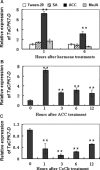
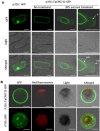
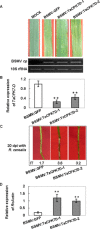
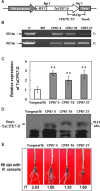
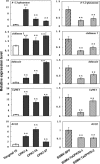
References
-
- Asano, T. , Tanaka, N. , Yang, G.X. , Hayashi, N. and Komatsu, S. (2005) Genome‐wide identification of the rice calcium‐dependent protein kinase and its closely related kinase gene families: comprehensive analysis of the CDPKs gene family in rice. Plant Cell Physiol. 46, 356–366. - PubMed
-
- Asano, T. , Hayashi, N. , Kobayashi, M. , Aoki, N. , Miyao, A. , Mitsuhara, I. , Ichikawa, H. , Komatsu, S. , Hirochika, H. , Kikuchi, S. and Ohsugi, R. (2012) A rice calcium‐dependent protein kinase OsCPK12 oppositely modulates salt‐stress tolerance and blast disease resistance. Plant J. 69, 26–36. - PubMed
-
- Cai, S.B. , Ren, L.J. , Yan, W. , Wu, J.Z. , Chen, H.G. , Wu, X.Y. and Zhang, X.Y. (2006) Germplasm development and mapping of resistance to sharp eyespot (Rhizoctonia cerealis) in wheat (in Chinese with English abstract). Sci. Agric. Sin. 39, 928–934.
Publication types
MeSH terms
Substances
LinkOut - more resources
Full Text Sources
Other Literature Sources
Molecular Biology Databases

